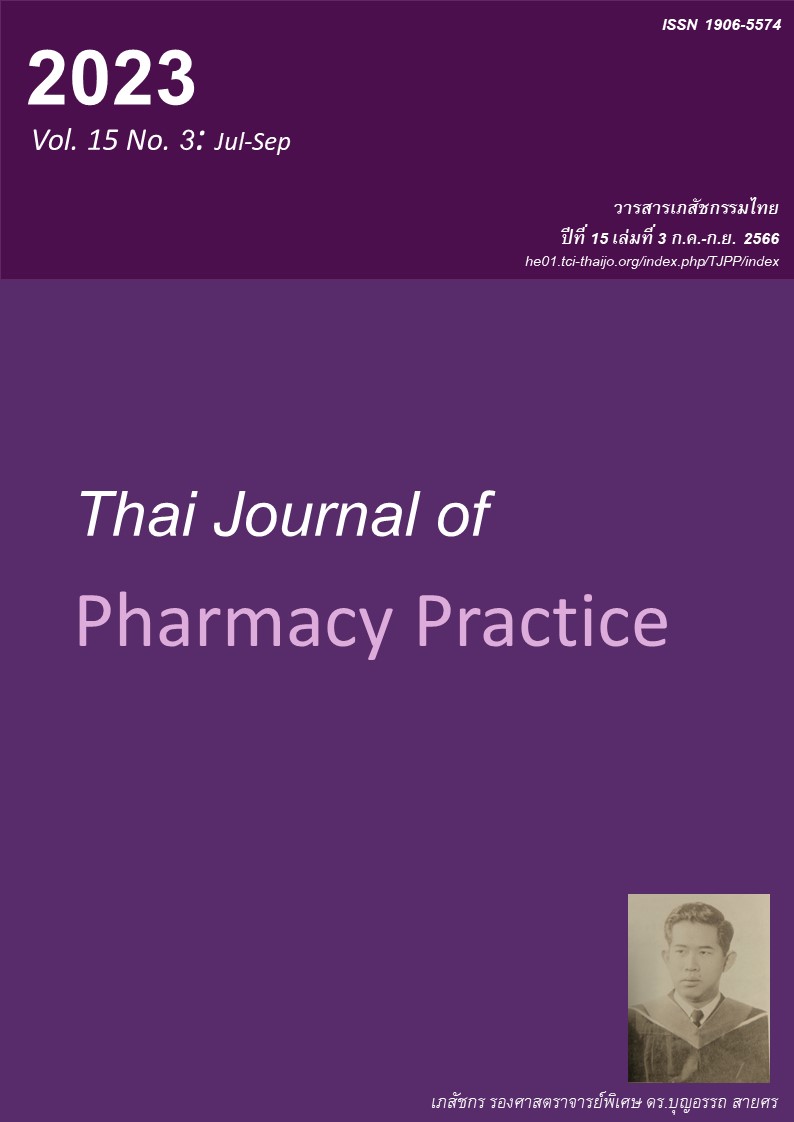Development of the Risk Assessment Tool of Prohibited Substances Use in Thai National Athletes
Main Article Content
Abstract
Objective: To develop and validate the risk assessment tool for prohibited substances use in Thai national athletes. Methods: The questionnaire was developed from literature review and tested for its content validity by 3 experts. Content validity index ranged from 0.67-1.00 and items were modified as recommended. The final version of Doping Risk Assessment Tool for Thai Athletes (DRATTAs) comprised 20 items for risk identification and 10 items for risk management. The tool was tested in 264 Thai National athletes chosen through multistage sampling. The study employed exploratory factor analysis with principal axis for data analysis. Results: The risk identification scale comprised 4 dimensions including risk related to need for reputation, wining and benefits, risks related to stakeholders and testing process for prohibited substance, risk related to self-confidence and knowledge on abstaining from prohibited substances, and risk from self-vigilance in using dietary supplements, herbs and medical services. Cronbach’s alpha reliability coefficients of these dimensions were 0.89, 0.69, 0.51, and 0.57, respectively. Risk management scale had two dimensions including positive risk management and denying and ignoring risk management with Cronbach’s 0.88 and 0.53 respectively. Conclusion: The developed scale in the dimensions of 1) risk related to need for reputation, wining and benefits, 2) risks related to stakeholders and testing process for prohibited substance and 3) positive risk management was valid and reliable. However, scales in the other dimensions had moderate reliability due to limited number of items. They need further improvement and testing.
Article Details

This work is licensed under a Creative Commons Attribution-NonCommercial-NoDerivatives 4.0 International License.
ผลการวิจัยและความคิดเห็นที่ปรากฏในบทความถือเป็นความคิดเห็นและอยู่ในความรับผิดชอบของผู้นิพนธ์ มิใช่ความเห็นหรือความรับผิดชอบของกองบรรณาธิการ หรือคณะเภสัชศาสตร์ มหาวิทยาลัยสงขลานครินทร์ ทั้งนี้ไม่รวมความผิดพลาดอันเกิดจากการพิมพ์ บทความที่ได้รับการเผยแพร่โดยวารสารเภสัชกรรมไทยถือเป็นสิทธิ์ของวารสารฯ
References
Mathichon Online. SAT helped swimmer athlete Ben to appeal on ban punishment following identified doping—over the concern on quitting from national team [online]. 2017 [cited Jul 5, 2022]. Available from: www.matichon .co.th/sport-slide/news_772496.
The NationThailand. Thai SEA Games medal winners disqualified [online]. 2017 [cited Jul 5, 2022]. Available from: www.nationthailand.com/detail/sport/30333951.
Ntoumanis N, Barkoukis V, Gucciardi DF, Chan DKC. Linking coach interpersonal style with athlete doping intentions and doping use: a prospective study. J Sport Exerc Psychol 2017; 39: 188-98.
World Anti-Doping Agency. International standards [on line]. no date [cited Nov 29, 2020]. Available from:www. wada-ama.org/en/what-we-do/international-standards.
George T. Doping risk assessment: Why it is important and how to proceed [online]. 2015 [cited Nov 29, 2020]. Available from: www.arisf.sport/download/wada/2015-5_tsamis_risk_assessment.pdf.
Henning A, McLean K, Andreasson J, Dimeo P. Risk and enabling environments in sport: systematic doping as harm reduction. Int J Drug Policy 2021; 91: 102897.
Fuller CW, Junge A, Dvorak J. Risk management: FIFA's approach for protecting the health of football players. Br J Sports Med 2012; 46: 11-7.
Aguilar-Navarro M, Salinero JJ, Muñoz-Guerra J, Plata MDM, Del Coso J. Sport-specific use of doping substances: Analysis of World Anti-Doping Agency doping control tests between 2014 and 2017. Subst Use Misuse 2020; 55(8): 1361-9.
Chorpecht J. Annual Report. Bangkok: Analytical Sciences and National Doping Test Institute; 2020.
Manasicha M. The letter announcement of Mahidol University. Bangkok: Analytical Sciences and National Doping Test Institute; 2018.
Wilson J, Tingle J. Clinical risk modification: a route to clinical governance. Oxford: Butterworth-Heinemann; 1999.
Malek S, Taylor J, Mansell K. A questionnaire examining attitudes of collegiate athletes toward doping and pharmacists as information providers. Can Pharm J (Ott) 2014; 147: 352-8.
Sport Doping Control Act B.E.2555. Royal Gazette No. 130, Part 2A (Jan 9, 2013).
Donovan R, Geoffrey JG, Gucciardi D. Research package for anti-doping organization [online]. [cited Nov 29, 2020]. Available from: www.wada-ama.org/ sites/default/files/resources/files/wada_social_science_research_package_ado.pdf.
World Anti-Doping Agency. World Anti-doping code 2015 [online]. 2015 [cited Jul 20, 2021]. Available from: www.wada-ama.org/sites/default/files/resources/files/w ada-2015-world-anti-doping-code.pdf.
World Anti-Doping Agency. The prohibited list [online]. no date [cited Jul 20, 2021]. Available from: www.wada-ama.org/en/prohibited-list.
El-Hammadi M, Hunien B. Exploring knowledge, attitudes and abuse concerning doping in sport among Syrian pharmacy students. Pharmacy 2013; 1: 94-106.
Hinton PR, McMurray I, Brownlow C. SPSS explained. New York: Routledge; 2014. p. 359.
Green SB, Lissitz RW, Mulaik SA. Limitations of coefficient alpha as an index of test unidimensionality. Educ Psychol Measure 1977; 37: 827-38.
Blank C, Leichtfried V, Schaiter R, Furhapter C, Muller D, Schobersberger W. Doping in sports: knowledge and attitudes among parents of Austrian junior athletes. Scand J Med Sci Sports 2015; 25: 116-24.
Jural LA, Soares TRC, Coqueiro RDS, Rabello TB, Pithon MM, Maia LC. Development, validation and application of a Brazilian knowledge scale about sports doping in dentistry. Braz Oral Res 2021;35:e110.
Stanger N, Whitaker L, Backhouse SH. Testing the validity and reliability of the doping willingness in sport scale. Scand J Med Sci Sports 2020; 30: 1529-43.


